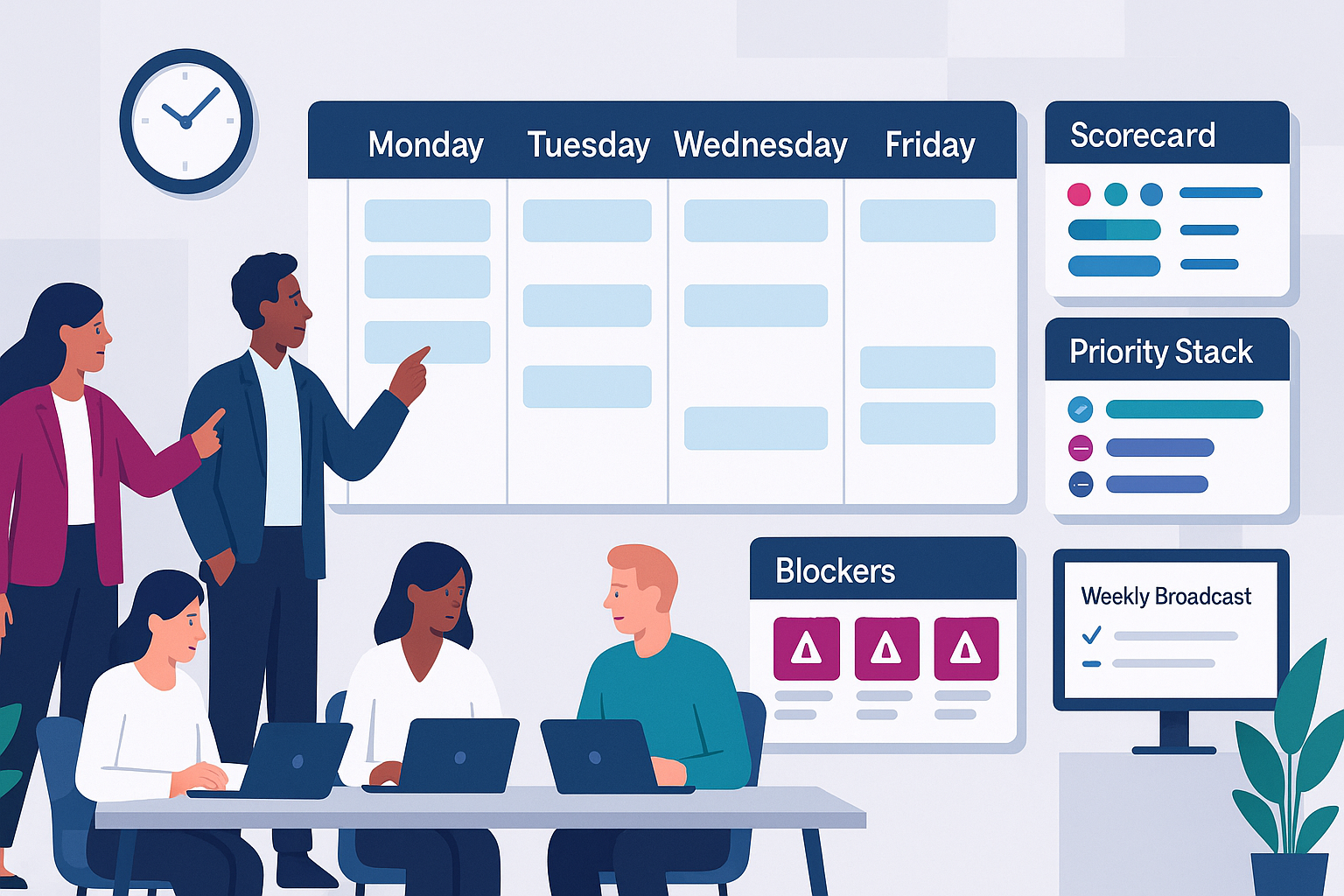
Build a Weekly Leadership Rhythm That Works Week After Week
What a weekly leadership rhythm solves
A strong weekly rhythm attacks the root causes of organisational drag. It is not another layer of meetings. It is the operating spine that gets everyone on the same page and keeps them there.
- Alignment collapse. People work hard on different things. The rhythm resets focus every Monday and checks it midweek.
- Slipping execution. Tasks fall through cracks. The rhythm builds a visible follow‑up system and clear ownership.
- Culture dilution. Growth means you no longer know everyone. The rhythm reinforces behaviours and standards every week.
- Cross‑team friction. Work crosses boundaries, clients expect seamless delivery. The rhythm creates a predictable cross‑functional touchpoint.
- Bureaucracy creep. More policies, slower moves. The rhythm pushes decisions to the right level and clears blockers fast.
- Truth decay. Fewer honest conversations. The rhythm hardwires one‑to‑ones and written pre‑reads to elevate signal.
- Innovation stall. New ideas distract or disappear. The rhythm dedicates a slot for pipeline review without derailing operations.
Core principles of a rhythm that actually works
Before the blueprint, lock in these principles. They separate effective cadence from calendar theatre.
- One source of truth. Use a single priority stack and a single scorecard. No parallel lists.
- Timeboxing. Respect start and end times. Keep meetings to 25, 50, or 90 minutes. Short beats vague.
- Decision cadence. Decisions have a weekly SLA. If an item misses two cycles, escalate or kill it.
- WIP limits. Cap active strategic initiatives. Most teams should run 3 to 5 at any one time.
- Written over spoken. Pre‑reads precede key meetings. Reduce verbal status updates to under two minutes.
- Short feedback loops. Plan Monday, adjust Wednesday, review Friday. Do not wait a month to fix flow.
- Visible metrics. Track leading and lagging indicators. Publish every Friday.
- Meeting hygiene. Clear purpose, agenda, owner, inputs, and outputs. No agenda, no meeting.
- Protected focus. Block two daily focus windows for deep work. The calendar must reflect priorities.
The weekly leadership rhythm: a day‑by‑day blueprint
Monday: Kick‑off, priorities, and risk
Purpose. Align on the week, lock the priority stack, surface risks early.
Suggested blocks.
- 09:00–10:30 Weekly Kick‑off with the leadership team
- 11:00–12:00 Risk and dependency review with delivery leaders
- 15:30–15:45 Whole‑org weekly broadcast or note
Inputs.
- Draft Priority Stack for the week
- Scorecard from last Friday
- Open Decision Log items and blockers
Agenda for Weekly Kick‑off (90 minutes).
- Business snapshot. 10 minutes. Only deltas and exceptions.
- Priority Stack finalise. 25 minutes. Confirm top 3 to 5 priorities and owners.
- Blockers and risks. 20 minutes. Identify owners, due dates, and escalation paths.
- Decision Log. 20 minutes. Close what is ready. Assign what is not.
- Communications. 15 minutes. Who needs to know what, by when, and how.
Outputs.
- Final Priority Stack with owners and due dates
- Updated Decision Log with next actions and SLAs
- Weekly broadcast to the organisation by 16:00
Tuesday: One‑to‑ones, coaching, and talent
Purpose. Keep relationships strong and performance clear. Raise truth early.
Suggested blocks.
- 09:00–12:00 One‑to‑ones with direct reports
- 14:00–15:00 Talent and capacity check with People lead
Standard one‑to‑one agenda (45 to 50 minutes).
- Check‑in. 5 minutes. Workload, energy, blockers.
- Progress. 10 minutes. Against last week’s commitments. No slide decks.
- Priorities. 15 minutes. Confirm this week’s top 3. Clarify support.
- Development. 10 minutes. Skill focus or feedback. One item, not ten.
- Admin. 5 minutes. Holidays, approvals, housekeeping.
Outputs.
- Updated commitments for each direct report
- Notes captured in shared one‑pager
- Development actions added to backlog
Wednesday: Decision day and deep work
Purpose. Make the decisions that move the needle. Protect focus for complex work.
Suggested blocks.
- 09:00–10:30 Decision Forum with pre‑reads
- 10:30–12:00 Deep work block
- 14:00–16:00 Deep work block
Decision Forum format.
- Pre‑reads sent by Tuesday 16:00. Two pages max. Problem, options, recommendation, risks.
- Silent start. 10 minutes reading. No slides, no monologues.
- Clarifying questions. 10 minutes. Facts before opinions.
- Debate. 20 minutes. Trade‑offs explicit.
- Decide. 10 minutes. Owner, due date, success metric.
Outputs.
- Decisions posted to the Decision Log within 30 minutes
- Impacted teams notified by 12:00
Thursday: Cross‑functional flow and customer outcomes
Purpose. Remove cross‑team friction and keep the customer experience coherent.
Suggested blocks.
- 09:00–10:30 Cross‑functional Flow Review
- 13:00–14:00 Customer or client pipeline review
Cross‑functional Flow Review agenda.
- Flow metrics. 10 minutes. Queue age, blocked items, handoff defects.
- Interfaces. 25 minutes. Marketing to Sales. Sales to Delivery. Delivery to Support. Fix handoffs.
- Incident review. 20 minutes. Rapid retrospective on any customer pain in the last week.
- Upcoming changes. 20 minutes. Releases, campaigns, migrations. Coordinate capacity.
- Actions. 15 minutes. Owners, due dates, and communications.
Outputs.
- Reduced queue age and fewer blocked items
- Clear owners for cross‑team actions
- Customer impact notes shared with all frontline teams
Friday: Review, learning, and reset
Purpose. Close the loop on execution. Learn. Prepare the next cycle.
Suggested blocks.
- 09:00–10:00 Weekly Performance Review
- 11:00–12:00 Retrospective or after‑action review, rotating topic
- 15:30–16:00 Wins, gratitude, and preview note
Weekly Performance Review agenda.
- Scorecard. 20 minutes. Red, amber, green. Focus on reds and ambers. Owners explain fixes.
- Delivery outcomes. 15 minutes. Planned vs done. Unplanned work ratio.
- Risks and decisions. 15 minutes. Any misses against SLA.
- Preview next week. 10 minutes. Known events and capacity flags.
Outputs.
- Updated Scorecard published to the org
- Action list for next week’s Kick‑off
- Short note celebrating wins and calling out learning
The 90‑minute leadership meeting that never wastes time
If you run only one meeting, make it this. Monday Kick‑off drives the week. Use this standard and never improvise the structure.
Inputs due by 17:00 Friday.
- Scorecard with last week’s results
- Draft Priority Stack with proposed owners
- Decision Log with pending items
- Risk register with top issues and likelihood
Agenda timebox.
- 0–10. Snapshot and exceptions.
- 10–35. Priorities lock. 3 to 5 only.
- 35–55. Blockers and risks. Assign owners and deadlines.
- 55–75. Decisions. Close what is ready, frame what needs data.
- 75–90. Communications. Who needs to know what and when.
Rules.
- No status readouts longer than two minutes per function.
- No slides. Pre‑reads or live dashboards only.
- If a topic needs more than 10 minutes, park it for the Decision Forum.
The artefacts that make the rhythm work
Rituals fail without shared artefacts. Use these six. Keep them lean and live.
- Priority Stack. A single list of this week’s top 3 to 5 priorities at org and team levels. Fields. Priority, owner, outcome, due date, dependencies, risk notes.
- Decision Log. Every material decision with context and accountability. Fields. Decision, date, owner, rationale, impacted teams, due date, success metric, review date.
- Blockers Board. Visible list of obstacles that leaders must remove. Fields. Blocker, owner, age in days, impact, next step.
- Weekly Brief. One‑page Sunday or Monday morning brief from each function. Sections. What matters this week, risks, asks, upcoming changes.
- Scorecard. A small set of leading and lagging indicators. Examples. Pipeline coverage, cycle time, net revenue retention, NPS, defect rates, employee capacity.
- Communications Plan. Who needs to hear what, when, and via which channel. Include clients when relevant.
Metrics to monitor the health of your rhythm
You cannot improve what you cannot see. Track the health of the rhythm itself.
- Planned vs done. Percentage of Priority Stack items completed by Friday. Target 80 percent or more.
- Work in progress. Number of concurrent strategic initiatives. Target 3 to 5.
- Queue age. Median days items sit waiting for cross‑team inputs. Target falling trend.
- Decision SLA. Percentage of decisions closed within one weekly cycle. Target 90 percent or more.
- Meeting load. Average weekly meeting hours per leader. Target under 20 hours. Lower is better if outcomes hold.
- 1:1 completion rate. Percentage of scheduled one‑to‑ones completed on time. Target 95 percent or more.
- Unplanned work ratio. Unplanned hours as a share of total. Target under 20 percent.
- Risk burndown. Number of top risks open week over week. Target downward slope.
- Employee pulse. Weekly two‑question check. Focus and friction scores from 1 to 5. Target 4 or better.
Rules, rituals, and etiquette that protect the rhythm
Protect the cadence like a critical system. The enemy is drift.
- No agenda, no meeting. Cancel rather than improvise.
- Pre‑reads by 16:00 the day before. Anything later moves to the next cycle.
- Start on time. End five minutes early. Always.
- Cameras on for decision‑making meetings. Humans decide better when they see each other.
- Silence is consent within the meeting. Raise objections in the room, not after.
- Document decisions within 30 minutes. Share widely.
- Two daily focus windows of 90 minutes. They are sacred. Calendar shows them.
- Slack and email windows. 20 minutes after each meeting block. Not constant drip.
Rituals to anchor culture.
- Monday 16:00 broadcast. One page. Priorities, risks, and focus. No fluff.
- Thursday two‑hour no‑meeting block across the org. Fix hard problems.
- Friday wins thread. Three specific wins and one learning. Public and short.
Variations for context
You should adapt the rhythm, not abandon it. Use these variations to fit your reality.
Start‑ups under 50 people.
- Collapse Monday Kick‑off to 60 minutes.
- Combine Decision Forum and Cross‑functional Flow Review into one 60‑minute block on Wednesday.
- Keep the artefacts, reduce the ceremony.
Remote‑first teams.
- Replace stand‑ups with written daily check‑ins at 09:00 local time. Template. Yesterday, today, blocked.
- Record short videos for the Monday broadcast. Keep under three minutes.
- Use asynchronous pre‑reads with hard cut‑offs to protect decision speed.
Customer‑facing weeks with heavy volatility.
- Daily 15‑minute triage at 16:30 to re‑prioritise client commitments.
- Keep Thursday customer pipeline review, but raise the frequency of incident reviews.
Product and engineering heavy organisations.
- Add a weekly design review on Wednesday 13:00–14:00. Pre‑reads include prototypes.
- Track deployment frequency, change failure rate, and mean time to recovery on the Scorecard.
Professional services and project‑based teams.
- Run a Monday revenue and capacity huddle for 30 minutes before Kick‑off.
- Add Friday client satisfaction pulse. Three metrics. Quality, timeliness, communication.
Troubleshooting and anti‑patterns
When the rhythm fails, it is usually for predictable reasons. Fix them fast.
- Too many priorities. Symptom. Nothing finishes. Fix. Enforce WIP limits. Park or kill lower items.
- Meetings without decisions. Symptom. Topics roll week to week. Fix. Tight pre‑reads. Decision owner named before the meeting.
- Skipping one‑to‑ones. Symptom. Surprise resignations or performance issues. Fix. Protect Tuesday mornings like revenue.
- Status theatre. Symptom. Long updates, little action. Fix. Dashboards only. Two‑minute limits. Cut to decisions.
- Calendar sprawl. Symptom. No focus time left. Fix. Two daily focus blocks. Ban hour‑long default slots.
- No visible artefacts. Symptom. Confusion about the truth. Fix. Maintain public Priority Stack and Decision Log.
- Drift after two months. Symptom. Energy fades. Fix. Quarterly cadence audit. Remove one meeting. Reinforce rules.
Implementation plan: a 14‑day rollout
Move fast. Two weeks is enough to stand up the core.
Week 0. Preparation.
- Choose the artefact platform. Keep it simple.
- Draft the Scorecard and Priority Stack templates.
- Schedule the five weekly anchors. Protect the time.
- Write the meeting charters. Purpose, agenda, inputs, outputs, owner.
Week 1. Pilot and stabilise.
- Run Monday Kick‑off with draft inputs. Be ruthless on WIP.
- Hold one‑to‑ones on Tuesday. Capture commitments in shared one‑pagers.
- Use the Decision Forum on Wednesday. Enforce pre‑reads and silent start.
- Run Cross‑functional Flow Review on Thursday. Fix one handoff.
- Publish the Scorecard on Friday. Celebrate one win.
Week 2. Improve and embed.
- Trim any meeting that did not create decisions or unblock work.
- Tighten the Scorecard to 8 to 12 measures.
- Add the weekly broadcast and wins thread.
- Coach the team on pre‑reads and concise speaking.
Day 15. Audit and adjust.
- Review metrics. Planned vs done, Decision SLA, meeting load.
- Gather feedback from directs. What to cut, keep, or change.
- Lock the cadence for the next eight weeks. Consistency beats novelty.
The big picture: how the rhythm connects to the system
A weekly leadership rhythm is not a calendar trick. It is the operational expression of a healthy organisation. Through the lens of the PerformanceNinja 6Ps, it looks like this.
- Purpose. Monday broadcasts and the Priority Stack keep the why visible, so teams align decisions to intent.
- People. Tuesday one‑to‑ones and talent checks grow capability and catch issues before they become crises.
- Proposition. Wednesday decisions keep strategy active, kill zombie projects, and sharpen value delivery.
- Process. Thursday flow reviews clean interfaces and reduce handoff defects, which increases speed.
- Productivity. The Scorecard, WIP limits, and decision SLAs make execution measurable and predictable.
- Potential. Dedicated slots for design and innovation protect the future without derailing the present.
Frequently asked questions the first month
Leaders often ask the same questions when they adopt this cadence. Here are the direct answers.
- How strict should we be with the timeboxes. Very. Flex the content, not the clock.
- What if we miss a pre‑read deadline. It moves to the next cycle. No exceptions.
- How many metrics on the Scorecard. Eight to twelve. More is noise.
- How long to see results. Two cycles to feel order. Six to embed habits. Twelve to see cultural shift.
- What if a crisis hits. Use the same artefacts. Update the Priority Stack. Run short daily triage. Protect one focus block.
Your Monday morning checklist
Print this and put it by your desk. Run it every week.
- Review Friday’s Scorecard. Note reds and ambers.
- Draft the Priority Stack. Cap at five. Pre‑assign owners.
- Confirm Decision Forum pre‑reads are due by Tuesday 16:00.
- Prepare the Monday broadcast outline. Keep it to one page.
- Protect your two daily focus blocks. Update your calendar.
Close: Start next Monday and do not let go
A weekly leadership rhythm that works is not complex. It is disciplined. You will feel awkward at first. That is normal. By week three, the noise drops. By week six, people anticipate the cadence and come prepared. By week twelve, you have a system that aligns, decides, and delivers. Start next Monday. Keep the promise every week after.
Next Steps
Want to learn more? Check out these articles:
10 Development Areas for Successful Leaders [Expert Guide]
Leading in an AI World: Why Human Leadership Matters Today
Leadership Development for Remote Teams: A Tactical Playbook
To find out how PerformanceNinja could help you, book a free strategy call or take a look at our Performance Intelligence Leadership Development Programme.




